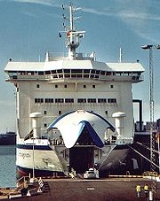
RORO
Encyclopedia
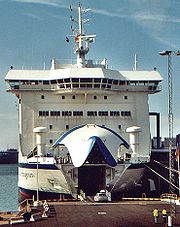
Ship
Since the end of the age of sail a ship has been any large buoyant marine vessel. Ships are generally distinguished from boats based on size and cargo or passenger capacity. Ships are used on lakes, seas, and rivers for a variety of activities, such as the transport of people or goods, fishing,...
s are vessels designed to carry wheeled cargo
Cargo
Cargo is goods or produce transported, generally for commercial gain, by ship, aircraft, train, van or truck. In modern times, containers are used in most intermodal long-haul cargo transport.-Marine:...
such as automobiles, truck
Truck
A truck or lorry is a motor vehicle designed to transport cargo. Trucks vary greatly in size, power, and configuration, with the smallest being mechanically similar to an automobile...
s, semi-trailer truck
Semi-trailer truck
A semi-trailer truck, also known as a semi, tractor-trailer, or articulated truck or articulated lorry, is an articulated vehicle consisting of a towing engine , and a semi-trailer A semi-trailer truck, also known as a semi, tractor-trailer, or (in the United Kingdom and Ireland) articulated truck...
s, trailers
Trailer (vehicle)
A trailer is generally an unpowered vehicle pulled by a powered vehicle. Commonly, the term trailer refers to such vehicles used for transport of goods and materials....
or railroad car
Railroad car
A railroad car or railway vehicle , also known as a bogie in Indian English, is a vehicle on a rail transport system that is used for the carrying of cargo or passengers. Cars can be coupled together into a train and hauled by one or more locomotives...
s that are driven on and off the ship on their own wheels. This is in contrast to lo-lo (lift-on/lift-off) vessels which use a crane
Crane (machine)
A crane is a type of machine, generally equipped with a hoist, wire ropes or chains, and sheaves, that can be used both to lift and lower materials and to move them horizontally. It uses one or more simple machines to create mechanical advantage and thus move loads beyond the normal capability of...
to load and unload cargo.
RORO vessels have built-in ramps
Drawbridge
A drawbridge is a type of movable bridge typically associated with the entrance of a castle surrounded by a moat. The term is often used to describe all different types of movable bridges, like bascule bridges and lift bridges.-Castle drawbridges:...
which allow the cargo to be efficiently "rolled on" and "rolled off" the vessel when in port. While smaller ferries that operate across river
River
A river is a natural watercourse, usually freshwater, flowing towards an ocean, a lake, a sea, or another river. In a few cases, a river simply flows into the ground or dries up completely before reaching another body of water. Small rivers may also be called by several other names, including...
s and other short distances often have built-in ramps, the term RORO is generally reserved for larger ocean-going vessels. The ramps and doors may be stern-only, or bow and stern for quick loading.
Types
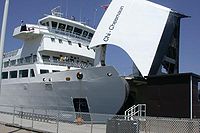

Ferry
A ferry is a form of transportation, usually a boat, but sometimes a ship, used to carry primarily passengers, and sometimes vehicles and cargo as well, across a body of water. Most ferries operate on regular, frequent, return services...
, cruiseferries, cargo ship
Cargo ship
A cargo ship or freighter is any sort of ship or vessel that carries cargo, goods, and materials from one port to another. Thousands of cargo carriers ply the world's seas and oceans each year; they handle the bulk of international trade...
s, and barge
Barge
A barge is a flat-bottomed boat, built mainly for river and canal transport of heavy goods. Some barges are not self-propelled and need to be towed by tugboats or pushed by towboats...
s. New automobiles that are transported by ship are often moved on a large type of RORO called a Pure Car Carrier (PCC) or Pure Car Truck Carrier (PCTC).
Elsewhere in the shipping industry cargo is normally measured by the metric tonne, but RORO cargo is typically measured in units of 'lanes in meters' (LIMs). This is calculated by multiplying cargo length in meters by the number of decks and by its width in lanes (lane width differs from vessel to vessel and there are several industry standards). Aboard PCCs cargo capacity is often measured in RT or RT43 units which is based on a 1966 Toyota or by car equivalent units (CEU).
The largest RORO passenger ferry is , a 75,100 GT cruise ferry that entered service in September 2007 for Color Line. Built in Finland
Finland
Finland , officially the Republic of Finland, is a Nordic country situated in the Fennoscandian region of Northern Europe. It is bordered by Sweden in the west, Norway in the north and Russia in the east, while Estonia lies to its south across the Gulf of Finland.Around 5.4 million people reside...
by Aker Finnyards, it is 223.7 metre long, 35 metre wide and can carry 550 cars as well as 1270 lane meters of cargo.
The RORO passenger ferry with the greatest car-carrying capacity is the Ulysses (named after a novel by James Joyce
James Joyce
James Augustine Aloysius Joyce was an Irish novelist and poet, considered to be one of the most influential writers in the modernist avant-garde of the early 20th century...
) which is owned by Irish Ferries. The Ulysses entered service on 25 March 2001 and operates between Dublin and Holyhead
Holyhead
Holyhead is the largest town in the county of Anglesey in the North Wales. It is also a major port adjacent to the Irish Sea serving Ireland....
. The 50,938 GT ship is 209.02 metre long and 31.84 metre wide, and can carry 1342 cars and 4101 lane meters of cargo.
History
At first, wheeled vehicles carried as cargo on oceangoing ships were treated like any other cargo.Automobiles had their fuel tanks emptied and their batteries disconnected before being hoisted into the ship’s hold, where they were chocked and secured. This process was tedious and difficult, vehicles were subject to damage, and could not be used for routine travel.
The world's first roll-on/roll-off service was a railway ferry
Train ferry
A train ferry is a ship designed to carry railway vehicles. Typically, one level of the ship is fitted with railway tracks, and the vessel has a door at the front and/or rear to give access to the wharves. In the United States, train ferries are sometimes referred to as "car ferries", as...
, started in 1833 by the Monkland and Kirkintilloch Railway
Monkland and Kirkintilloch Railway
The Monkland and Kirkintilloch Railway was an early mineral railway running from a colliery at Monklands to the Forth and Clyde Canal at Kirkintilloch, Scotland....
which operated a wagon ferry on the Forth and Clyde Canal
Forth and Clyde Canal
The Forth and Clyde Canal crosses Scotland, providing a route for sea-going vessels between the Firth of Forth and the Firth of Clyde at the narrowest part of the Scottish Lowlands. The canal is 35 miles long and its eastern end is connected to the River Forth by a short stretch of the River...
in Scotland
Scotland
Scotland is a country that is part of the United Kingdom. Occupying the northern third of the island of Great Britain, it shares a border with England to the south and is bounded by the North Sea to the east, the Atlantic Ocean to the north and west, and the North Channel and Irish Sea to the...
.
During WWII, Landing Ships were among the first seagoing ships enabling road vehicles to roll directly on and off. Post war, the idea was adopted for merchant ships and short ferry crossings. The first RoRo service crossing the English channel began from Dover
Dover
Dover is a town and major ferry port in the home county of Kent, in South East England. It faces France across the narrowest part of the English Channel, and lies south-east of Canterbury; east of Kent's administrative capital Maidstone; and north-east along the coastline from Dungeness and Hastings...
in 1953.
In 1957 the US military issued a contract to the Sun Shipbuilding and Dry Dock Company
Sun Shipbuilding & Drydock Co.
Sun Shipbuilding & Drydock Company was a major shipbuilding company in Chester, Pennsylvania, about 15 miles south of Philadelphia on the Delaware River. Its primary product was tankers, but the company built many types of ships over its 70-year history. During World War II, it participated in the...
in Chester, PA
Chester, Pennsylvania
Chester is a city in Delaware County, Pennsylvania, United States, with a population of 33,972 at the 2010 census. Chester is situated on the Delaware River, between the cities of Philadelphia and Wilmington, Delaware.- History :...
for the construction of a new type of motorized vehicle carrier. The ship, Comet, had a stern ramp as well as interior ramps which allowed cars to drive directly from the dock, onto the ship, and into place. Loading and unloading was sped up dramatically. Comet also had an adjustable chocking system for locking cars onto the decks, and a ventilation system to remove exhaust gases that accumulate during vehicle loading.
Car carriers
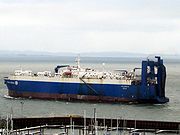
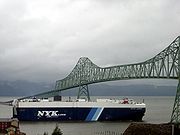

K Line
, also referred to as "K" Line, is a very large Japanese shipping company. It owns and/or controls large cargo ships, including dry cargo ships, container ships, container terminals, gas carriers, RoRo ships and tankers....
built European Highway, the first pure car carrier (PCC), which carried 4,200 automobiles. Today’s pure car carriers and their close cousins, the pure car/truck carrier (PCTC) are distinctive ships with a box-like superstructure running the entire length and breadth of the hull, fully enclosing the cargo. They typically have a stern ramp and a side ramp for dual loading of thousands of vehicles, and extensive automatic fire control systems.
The PCTC has liftable decks to increase vertical clearance as well as heavier decks for "high and heavy" cargo. A 6500 unit car ship with 12 decks can have three decks which can take cargo up to 150 ST (136 t; 134 LT) with liftable panels to increase clearance from 1.7 metre on some decks. Lifting decks to accommodate higher cargo reduces the total capacity.
With the building of the Wallenius Wilhelmsen Logistics's 8000 CEU car carrier Faust, out of Stockholm, in June 2007 the car carriers entered a new era called the large car and truck carrier (LCTC).
The car carrier, Auriga Leader
Auriga Leader
Auriga Leader is a car carrier owned by Nippon Yusen used for shipping Toyota cars from Japan to USA. It is the first ship in the world to be partially propelled by solar power.- Experimental :...
, built in 2008 with a capacity of 6,200 cars, is the world's first partially solar powered ship.
Seaworthiness
The seagoing RORO car ferry, with large external doors close to the waterline and open vehicle decks with few internal bulkheadsBulkhead (partition)
A bulkhead is an upright wall within the hull of a ship or within the fuselage of an airplane. Other kinds of partition elements within a ship are decks and deckheads.-Etymology:...
, has a reputation for being a high risk design (to the point where the acronym is sometimes derisively expanded "Roll On/Roll Over"). An improperly-secured loading door can cause a ship to take on water and sink, as happened for example in 1987 with the MS Herald of Free Enterprise. Water sloshing on the vehicle deck can set up a free surface effect
Free Surface Effect
The free surface effect is one of several mechanisms which can cause a craft to become unstable and roll over . It refers to the tendency of liquids — and of aggregates of small solid objects, like seeds, gravel, or crushed ore which can act as liquids — to slosh about: to move in response to...
making the ship unstable and causing it to capsize. Free surface water on the vehicle deck was determined by the Court of Inquiry to be the immediate cause of the 1968 capsize of the TEV Wahine
Wahine disaster
The Wahine disaster occurred on 10 April 1968 when the TEV Wahine, a New Zealand inter-island ferry of the Union Company, foundered on Barrett Reef at the entrance to Wellington Harbour and capsized near Steeple Rock...
in New Zealand.
Despite these inherent risks, the very high freeboard
Freeboard (nautical)
In sailing and boating, freeboardmeans the distance from the waterline to the upper deck level, measured at the lowest point of sheer where water can enter the boat or ship...
raises the seaworthiness of these vessels. For example, the car carrier MV Cougar Ace listed 80 degrees to its port side in 2006, but did not sink, since its high enclosed sides prevented water from entering.
ROPAX
The acronym ROPAX (roll on/roll off passenger) describes a RORO vessel built for freight vehicle transport along with passenger accommodation. Technically this encompasses all ferries with both a roll on/roll off car deck and passenger-carrying capacities, but in practice ships with facilities for more than 500 passengers are often referred to as cruiseferriesCruiseferry
A cruiseferry is a ship that combines the features of a cruise ship with a Ro-Pax ferry. Many passengers travel with the ships for the cruise experience, staying only a few hours at the destination port or not leaving the ship at all, while others use the ships as means of...
.
ConRO
The ConRo vessel is a hybrid between a RORO and a container shipContainer ship
Container ships are cargo ships that carry all of their load in truck-size intermodal containers, in a technique called containerization. They form a common means of commercial intermodal freight transport.-History:...
. This type of vessel has a below-decks area used for vehicle storage while stacking containerized
Intermodal container
An intermodal container is a standardized reusable steel box used for the safe, efficient and secure storage and movement of materials and products within a global containerized intermodal freight transport system...
freight on the top decks. Examples of ConRo ships such as those in the fleet of Atlantic Container Line can carry a combination of 1,900 twenty-foot equivalent unit
Twenty-foot equivalent unit
The twenty-foot equivalent unit is an inexact unit of cargo capacity often used to describe the capacity of container ships and container terminals...
s (TEUs) of containers, up to 1,000 TEUs of heavy equipment, as well as project and oversized cargo on three decks and up to 2,000 automobiles on five decks. Separate internal ramp systems within the vessel segregate automobiles from other vehicles, mafi trailers and breakbulk cargo.
RoLo
A RoLo (roll-on lift-off) vessel is another hybrid vessel type with ramps serving vehicle decks but with other cargo decks accessible only by crane.See also
- FerryFerryA ferry is a form of transportation, usually a boat, but sometimes a ship, used to carry primarily passengers, and sometimes vehicles and cargo as well, across a body of water. Most ferries operate on regular, frequent, return services...
- Car floatCar floatA railroad car float or rail barge is an unpowered barge with rail tracks mounted on its deck. It is used to move railroad cars across water obstacles, or to locations they could not otherwise go, and is pushed by a towboat or towed by a tugboat...
- Train ferryTrain ferryA train ferry is a ship designed to carry railway vehicles. Typically, one level of the ship is fitted with railway tracks, and the vessel has a door at the front and/or rear to give access to the wharves. In the United States, train ferries are sometimes referred to as "car ferries", as...
- Car float
- Konkan Railway CorporationKonkan Railway CorporationKonkan Railway Corporation is a subsidiary of the Indian Railways . It operates the Konkan Railways, a subsidiary zone of the Indian Railways. It is headquartered at Belapur in Navi Mumbai. The company started its full operations of trains on 26 January 1998...
- List of RORO vessel accidents
- Merchant ship
- Motor vessel
- Rolling highwayRolling HighwayA rolling highway is a combined transport system to transport trucks by rail....
- Yacht TransportYacht TransportYacht transport is the shipping of a yacht to a destination instead of sailing or motoring it. Yacht transport is an alternative to the traditional passaging to reach desireddestinations around the globe...

